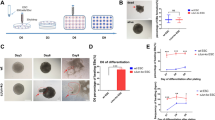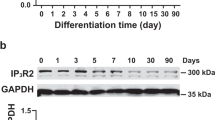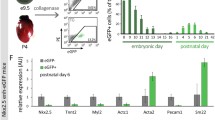Summary
Thymosin β4 (Tβ4) is a key factor in cardiac development, growth, disease, epicardial integrity, blood vessel formation and has cardio-protective properties. However, its role in murine embryonic stem cells (mESCs) proliferation and cardiovascular differentiation remains unclear. Thus we aimed to elucidate the influence of Tβ4 on mESCs. Target genes during mESCs proliferation and differentiation were detected by real-time PCR or Western blotting, and patch clamp was applied to characterize the mESCs-derived cardiomyocytes. It was found that Tβ4 decreased mESCs proliferation in a partial dose-dependent manner and the expression of cell cycle regulatory genes c-myc, c-fos and c-jun. However, mESCs self-renewal markers Oct4 and Nanog were elevated, indicating the maintenance of self-renewal ability in these mESCs. Phosphorylation of STAT3 and Akt was inhibited by Tβ4 while the expression of RAS and phosphorylation of ERK were enhanced. No significant difference was found in BMP2/BMP4 or their downstream protein smad. Wnt3 and Wnt11 were remarkably decreased by Tβ4 with upregulation of Tcf3 and constant β-catenin. Under mESCs differentiation, Tβ4 treatment did not change the expression of cardiovascular cell markers α-MHC, PECAM, and α-SMA. Neither the electrophysiological properties of mESCs-derived cardiomyocytes nor the hormonal regulation by Iso/Cch was affected by Tβ4. In conclusion, Tβ4 suppressed mESCs proliferation by affecting the activity of STAT3, Akt, ERK and Wnt pathways. However, Tβ4 did not influence the in vitro cardiovascular differentiation.
Similar content being viewed by others
References
Li T, Ma SY, Tang XC, et al. Production and characterization of highly purified recombinant thymosin beta 4 in Escherichia coli. Protein Expr Purif, 2013, 90(2): 90–95
Goldstein AL, Hannappel E, Sosne G, et al. Thymosin beta4: a multi-functional regenerative peptide. Basic properties and clinical applications. Expert Opin Biol Ther, 2012, 12(1): 37–51
Philp D, Nguyen M, Scheremeta B, et al. Thymosin beta4 increases hair growth by activation of hair follicle stem cells. FASEB J, 2004, 18(2): 385–387
Sosne G, Szliter EA, Barrett R, et al. Thymosin beta 4 promotes corneal wound healing and decreases inflammation in vivo following alkali injury. Exp Eye Res, 2002, 74(2): 293–299
Goldstein AL, Hannappel E, Kleinman HK. Thymosin beta4: actin-sequestering protein moonlights to repair injured tissues. Trends Mol Med, 2005, 11(9): 421–429
Piao Z, Hong CS, Jung MR, et al. Thymosin beta4 induces invasion and migration of human colorectal cancer cells through the ILK/AKT/beta-catenin signaling pathway. Biochem Biophys Res Commun, 2014, 452(3): 858–864
Cheng P, Kuang F, Zhang H, et al. Beneficial effects of thymosin beta4 on spinal cord injury in the rat. Neuropharmacology, 2014, 85: 408–416
Smart N, Risebro CA, Melville AA, et al. Thymosin beta4 induces adult epicardial progenitor mobilization and neovascularization. Nature, 2007, 445(7124): 177–182
Rui L, Yu N, Hong L, et al. Extending the time window of mammalian heart regeneration by thymosin beta 4. J Cell Mol Med, 2014, 18(12): 2417–2424
Gajzer DC, Balbin J, Chaudhry HW. Thymosin beta4 and cardiac regeneration: are we missing a beat? Stem Cell Rev, 2013, 9(3): 303–312
Smart N, Bollini S, Dube KN, et al. Myocardial regeneration: expanding the repertoire of thymosin beta4 in the ischemic heart. Ann N Y Acad Sci, 2012, 1269: 92–101
Stark C, Taimen P, Tarkia M, et al. Therapeutic potential of thymosin beta4 in myocardial infarct and heart failure. Ann N Y Acad Sci, 2012, 1269: 117–124
Evans MJ, Kaufman MH. Establishment in culture of pluripotential cells from mouse embryos. Nature, 1981, 292(5819): 154–156
Smith AG. Embryo-derived stem cells: of mice and men. Annu Rev Cell Dev Biol, 2001, 17: 435–462
Draper JS, Andrews PW. Embryonic stem cells: advances toward potential therapeutic use. Curr Opin Obstet Gynecol, 2002, 14(3): 309–315
Liew CG, Moore H, Ruban L, et al. Human embryonic stem cells: possibilities for human cell transplantation. Ann Med, 2005, 37(7): 521–532
Mingxia Z, Jinyuan Z, Guian C, et al. Early embryonic sensitivity to cyclophosphamide in cardiac differentiation from human embryonic stem cells. Cell Biol Int, 2011, 35(9): 927–938
Kupatt C, Bock-Marquette I, Boekstegers P. Embryonic endothelial progenitor cell-mediated cardioprotection requires Thymosin beta4. Trends Cardiovasc Med, 2008, 18(6): 205–210
Jeon BJ, Yang Y, Kyung Shim S, et al. Thymosin beta-4 promotes mesenchymal stem cell proliferation via an interleukin-8-dependent mechanism. Exp Cell Res, 2013, 319(17): 2526–2534
Yan B, Singla RD, Abdelli LS, et al. Regulation of PTEN/Akt pathway enhances cardiomyogenesis and attenuates adverse left ventricular remodeling following thymosin beta4 Overexpressing embryonic stem cell transplantation in the infarcted heart. PLoS One, 2013, 8(9): e75580
Banach K, Halbach MD, Hu P, et al. Development of electrical activity in cardiac myocyte aggregates derived from mouse embryonic stem cells. Am J Physiol Heart Circ Physiol, 2003, 284(6): H2114–2123
Zhu H, Yue J, Pan Z, et al. Involvement of Caveolin-1 in repair of DNA damage through both homologous recombination and non-homologous end joining. PLoS One, 2010, 5(8): e12055
Burdon T, Chambers I, Stracey C, et al. Signaling mechanisms regulating self-renewal and differentiation of pluripotent embryonic stem cells. Cells Tissues Organs, 1999, 165(3-4): 131–143
Niwa H, Ogawa K, Shimosato D, et al. A parallel circuit of LIF signalling pathways maintains pluripotency of mouse ES cells. Nature, 2009, 460(7251): 118–122
Wilson PA, Hemmati-Brivanlou A. Induction of epidermis and inhibition of neural fate by Bmp-4. Nature, 1995, 376(6538): 331–333
Hao J, Li TG, Qi X, et al. WNT/beta-catenin pathway up-regulates Stat3 and converges on LIF to prevent differentiation of mouse embryonic stem cells. Dev Biol, 2006, 290(1): 81–91
Sato N, Meijer L, Skaltsounis L, et al. Maintenance of pluripotency in human and mouse embryonic stem cells through activation of Wnt signaling by a pharmacological GSK-3-specific inhibitor. Nat Med, 2004, 10(1): 55–63
Crockford D, Turjman N, Allan C, et al. Thymosin beta4: structure, function, and biological properties supporting current and future clinical applications. Ann N Y Acad Sci, 2010, 1194: 179–189
Nichols J, Zevnik B, Anastassiadis K, et al. Formation of pluripotent stem cells in the mammalian embryo depends on the POU transcription factor Oct4. Cell, 1998, 95(3): 379–391
Niwa H, Miyazaki J, Smith AG. Quantitative expression of Oct-3/4 defines differentiation, dedifferentiation or self-renewal of ES cells. Nat Genet, 2000, 24(4): 372–376
Chambers I, Colby D, Robertson M, et al. Functional expression cloning of Nanog, a pluripotency sustaining factor in embryonic stem cells. Cell, 2003, 113(5): 643–655
Muller DW. The role of proto-oncogenes in coronary restenosis. Prog Cardiovasc Dis, 1997, 40(2): 117–128
Ye L, Zhang P, Duval S, et al. Thymosin beta4 increases the potency of transplanted mesenchymal stem cells for myocardial repair. Circulation, 2013, 128(11 Suppl 1): S32–41
Liu N, Lu M, Tian X, et al. Molecular mechanisms involved in self-renewal and pluripotency of embryonic stem cells. J Cell Physiol, 2007, 211(2): 279–286
Niwa H, Burdon T, Chambers I, et al. Self-renewal of pluripotent embryonic stem cells is mediated via activation of STAT3. Genes Dev, 1998, 12(13): 2048–2060
Burdon T, Stracey C, Chambers I, et al. Suppression of SHP-2 and ERK signalling promotes self-renewal of mouse embryonic stem cells. Dev Biol, 1999, 210(1): 30–43
Takahashi K, Murakami M, Yamanaka S. Role of the phosphoinositide 3-kinase pathway in mouse embryonic stem (ES) cells. Biochem Soc Trans, 2005, 33(Pt 6): 1522–1525
Cartwright P, McLean C, Sheppard A, et al. LIF/STAT3 controls ES cell self-renewal and pluripotency by a Myc-dependent mechanism. Development, 2005, 132(5): 885–896
Qi X, Li TG, Hao J, et al. BMP4 supports self-renewal of embryonic stem cells by inhibiting mitogen-activated protein kinase pathways. Proc Natl Acad Sci USA, 2004, 101(16): 6027–6032
Brannon M, Gomperts M, Sumoy L, et al. A beta-catenin/XTcf-3 complex binds to the siamois promoter to regulate dorsal axis specification in Xenopus. Genes Dev, 1997, 11(18): 2359–2370
Tam WL, Lim CY, Han J, et al. T-cell factor 3 regulates embryonic stem cell pluripotency and self-renewal by the transcriptional control of multiple lineage pathways. Stem Cells, 2008, 26(8): 2019–2031
Gómez-Márquez J, Franco del Amo F, Carpintero P, et al. High levels of mouse thymosin beta4 mRNA in differentiating P19 embryonic cells and during development of cardiovascular tissues. Biochim Biophys Acta, 1996, 1306(2-3): 187–193
Bock-Marquette I, Saxena A, White MD, et al. Thymosin beta4 activates integrin-linked kinase and promotes cardiac cell migration, survival and cardiac repair. Nature, 2004, 432(7016): 466–472
Banerjee I, Zhang J, Moore-Morris T, et al. Thymosin beta 4 is dispensable for murine cardiac development and function. Circ Res, 2012, 110(3): 456–464
Zhou B, Honor LB, Ma Q, et al. Thymosin beta 4 treatment after myocardial infarction does not reprogram epicardial cells into cardiomyocytes. J Mol Cell Cardiol, 2012, 52(1): 43–47
Philp D, St-Surin S, Cha HJ, et al. Thymosin beta 4 induces hair growth via stem cell migration and differentiation. Ann N Y Acad Sci, 2007, 1112: 95–103
Author information
Authors and Affiliations
Corresponding author
Additional information
This project was supposed by grants from National Natural Science Foundation of China (No. 81100818, No. 31100828 and No. 81070342), and the Fundamental Research Funds for the Central Universities (HUST: No. 2012TS036).
Rights and permissions
About this article
Cite this article
Nie, L., Gao, Sj., Zhao, Yn. et al. Thymosin β4 impeded murine stem cell proliferation with an intact cardiovascular differentiation. J. Huazhong Univ. Sci. Technol. [Med. Sci.] 36, 328–334 (2016). https://doi.org/10.1007/s11596-016-1587-6
Received:
Revised:
Published:
Issue Date:
DOI: https://doi.org/10.1007/s11596-016-1587-6




